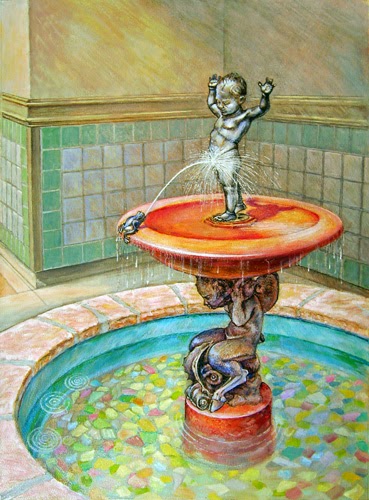An original acrylic painting, on illustration board
20 x 30", unframed, - ( mat size, 26 x 36' )
$2,200.00, plus $40.00, ( pack and ship )
The title of this painting is in the form of a question, as it might be asked by a small
child, who has seen and heard many video and literary references to the existence of
of the popular, mythical beings who live in the sea. People have been creating disastrous
legends and folk tales about encounters with mermaids since men first began to venture
forth on the sea, to fish or to voyage to distant lands in search of valuable trade goods.
And, even as late as the voyages of Columbus, a number of mermaids were reportedly
seen to frequent the waters of the new world. From Hans Christian Andersen to Walt
Disney, little mermaids have become a staple part of pop culture, thus reinforcing the
tales of ancient mythology, even as we have changed them from nightmare creatures,
luring men to their deaths, into fantasies for children's bedtime stories.
But some of the old folk tales survive, to be passed down from one generation to
the next, such as the Greek legend of Alexander The Great's sister Thessalonike.
After her death she was believed to have become one of the immortal mermaids who
lived in the Aegean Sea. Greek fisherman on passing ships were cautioned on how
to respond to her when she called out to them, "Is King Alexander alive?". The correct
answer to her question, is said to be, "He lives and reigns and conquers the world!"
On hearing this answer, the mermaid calms the waters and bids the ship farewell.
However, if the wrong answer is given, she is said to become enraged, and stirs up
a terrible storm to doom the ship and all aboard.
This painting is another from the series of fountain paintings which I have referred
to in previous postings, such as Neptune Rising, and A Sunrise Visitor, all of which
have the art objects of a well known shopping district in Kansas City, as reference
subjects on which I have based some new works, from time to time.. In this case,
the fountain features two large, carved, marble, mermaid figures, which are said to be
over three hundred years old, and which are blowing jets of water from their horns.
They were first installed here in 1930, facing each other from opposite ends of a
rectangular pool, and I first became acquainted with them in that configuration back
in the 1940's. The fountain pool was restyled in 1968, into a larger, modified-trefoil
design, with a circular, fountain spray added to increase the water display.
I chose to depict the fountain at a time of an approaching storm, with the mermaids
caught in the flickering light from the thickening clouds, with one mermaid in sun and
one in shadow. And in between the two, old, worn figures is a very young one, asking
the question, "Do the mermaids bring the storms?".
( click on image to enlarge )













